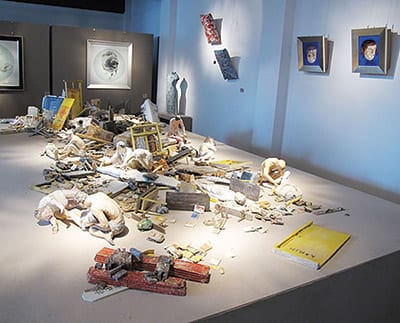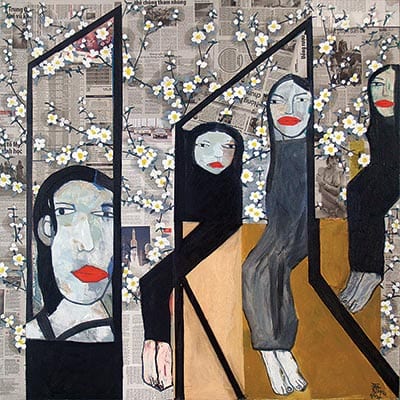Vietnamese art reflects a mixture of influences: Vietnamese traditional art, influences from China and influence from the French during the colonial period. Just over a decade ago Vietnam opened up to the world. The international art market started to see the talents of Vietnamese artists and the variety of styles in Vietnamese paintings. Demand for Vietnamese art is increasing rapidly, especially in France and other countries in Europe
During the past few years, Vietnamese Modern Art has assumed a more definite shape. ‘Doi Moi’, Vietnam’s Perestroika, introduced in 1986, allowed the creative artist more freedom.

At the end of the eighties, this resulted in an explosion in Vietnamese painting. Hundreds of artists participated in various exhibitions which were held in Hanoi, Ho Chi Minh-City, Hue, and Danang.
Just a few years ago, it was still impossible for Vietnamese artists to achieve international success. However, as a result of the recent economic developments in Vietnam, like the arrival of foreign investors, the Vietnamese art market has grown dramatically and has attracted the attention of the international community.
As a result of the recent economic developments in Vietnam, like the arrival of foreign investors, the Vietnamese art market has grown dramatically and has attracted the attention of the international community
Vietnamese painting is mainly a twentiethcentury phenomenon. In contrast to other Asian countries, Vietnamese artists in the feudal period did not practice the art of painting but devoted themselves to sculpture and the decoration of temples and pagodas.

At the end of the nineteenth century, the French introduced the technique of oil-painting to Vietnam, and in 1925 they established the ‘Ecole des Beaux-Art l’Indochine’ in Hanoi.
This marks the beginnings of a professional class of painters. The students at the ‘Ecole des Beaux-Art l’Indochine’ were given an education based on the traditional French model: they painted ‘after nature’ in a realistic and impressionistic style.
For half a century, Vietnamese art, especially in the North, was intended to serve the revolution. Artistic interests were of minor importance. Nudes, still-lifes, and abstract images were considered frivolous and egocentric, thus a betrayal of the socialist ideology.

These days, the contemporary Vietnamese artist is free to represent his or her inner self in his or her work. Despite this new liberal climate, Vietnamese art is not ‘innovating’ in a European sense. Vietnamese painting does not demand philosophical questions about the definition of painting itself. This springs from the indissoluble link between Vietnamese art and the political and social history of its country.
These days, a contemporary Vietnamese artist is free to represent their inner self in their work. Despite this new liberal climate, Vietnamese art is not ‘innovating’ in a European sense
The contemporary Vietnamese artist does not direct his attention to the (western) preoccupation with changing of the ‘frontiers’ of art.

The contemporary Vietnamese artist does not direct his attention to the (western) preoccupation with changing of the ‘frontiers’ of art. Since ‘Doi Moi’ there has been a revival in the use of traditional elements Since ‘Doi Moi’ there has been a revival in the use of traditional elements.

The painters are being influenced by the renewed interest in traditional village ceremonies and the renovation of historical sites, such as pagodas, tombs, and shrines.
The artists are drawn visually to ancient motifs, and through these to the soul and spirit of the Vietnamese cultural traditions.

The most significant change in contemporary Vietnamese art can be seen in the work itself. There is a great variety.
The artists are distinguishing themselves in style and technique. Not so long ago they worked for a collective goal (the revolution), now they are turning to their personal visions.